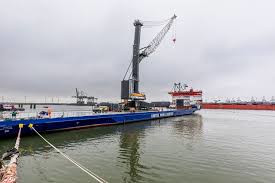Milestone for Marcor with Liebherr LHM 800 MHC
26 March 2024Marcor Stevedoring has received a new LHM 800 crane, the first of its kind to operate with an all-electric drive system.
With its 64-metre reach and peak dry bulk operating capacity exceeding 2,000 tons per hour, the mobile harbour crane aligns with Marcor’s bulk, bagged and containerized stevedoring operations at Marcor’s Hartel Terminal, serving as a logistical bridge between the port’s quay and storage warehouses for dry bulk cargo.
The crane will support a larger infrastructure at Marcor Stevedoring that handles approximately six million tons of loose, bagged and containerized bulk cargoes annually
A lifting capacity of 104 tons and SmartGrip technology enable the LHM 800 to increase the handling rate as the system utilises the grab capacity in full
“With the LHM 800, we have gained a competitive edge in the dry bulk market,” said Danny Swart, director, Marcor Stevedoring. “It is a versatile and powerful machine that can handle any type of cargo, from ore to grains and fertilizers. It also reduces our fuel consumption and emissions, which is in line with our sustainability goals.”
The LHM 800 fits into the strategic growth of the terminal’s expansion, with its focus on more sustainable operations by using more renewable energy and cleaner drive concepts.
A second LHM 800 has also been ordered and is scheduled to be shipped to Marcor later this year.
The Hartel Terminal has a 130,000 m² terminal and a 600-metre quay with a 16-metre draft alongside. It has vessel handling options from barges up to 120,000 DWT baby-cape vessels, both for board-to-board transhipments and discharge to/from the terminal.
Contributing to a greener bulk industry. And no Diesel engine is needed. The LHM 800 will do its work without generating additional local emissions and will also feature a quieter noise profile.
Under ideal operating conditions, upwards of 2,000 tons of dry bulk capacity can be achieved. A boom length of 64 metres and eye-level height of 30.8 metres ensure the crane can optimally load cargo between the quay and storage facilities.
The crane’s electric drive unit, ergonomic cabin, and more digital features like touch panel pave the way for future assistance and partial automation systems. These advantages make the crane’s operation more efficient, saving time and money for the operator.
The LHM 800 will be used for handling dry bulk commodities such as agri-bulk, biomass, fertilizers, and mineral bulk cargoes. The crane will increase the throughput and efficiency of the terminal, which is expected to reach 10 million tons per year by 2025.
In 2023, the throughput of dry bulk cargo at the Port of Rotterdam reached approximately 64 million metric tons. In 2022, the EU consumed a total of nearly 14.83 metric tons per capita of raw materials including biomass, metal ores, non-metallic minerals, and fossil energy materials.
According to a report of the World Bank, the European mineral raw materials industry demonstrated a considerable increase in the production of minerals needed for clean energy technologies. A range of minerals and metals for implementing renewable energy strategies and their related infrastructure are part of what is driving this growth. These include copper, lithium, nickel, cobalt, graphite, and more.
The LHM 800 is part of this growth strategy. The floating terminal in Rotterdam is supported by the expansion of the dry bulk terminal at the Hartel Terminal. This expansion has required redevelopment and construction of new and high-end storage facilities. Sustainable and efficient storage and stevedoring operations are being phased in at the site.
